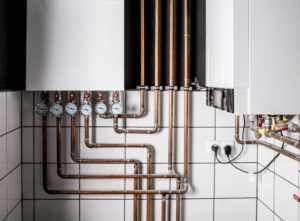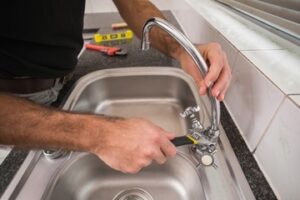A plumbing leak can cause a lot of problems for homeowners. They can lead to water damage, mold growth, and high water bills.
It is important to detect a leaky pipe early to fix it quickly. There are a few ways to do this, including checking the water meter. Click here to Learn More.

One of the first indicators that you leak is when you notice an increase in your water bill. Water leaks aren’t a cheap problem to ignore, and if they are left unchecked, they can lead to water damage that requires costly repair and cleaning services. But the good news is that you can often catch these leaks early on by checking your water meter for signs of a leak.
Water meters are designed to help you check on your water usage so that you know whether you have a leak in your plumbing system or if there’s a billing issue with your utility provider. A simple inspection of your meter can tell you what the problem is, and it’s much cheaper than calling in a plumber for an investigation.
The first step is to make sure that all of the water use sources in your home are turned off. This includes faucets, ice makers, dishwashers and washing machines. You should also shut off the water to your showers and any tubs that you have. Once you’ve made sure that all of the water is off, you can go to your water meter and look at the dials. You should be able to see a small pinwheel with black and silver stripes or a triangle dial on your water meter that shows whether you’re using any water.
If you notice that the meter is turning even though you’re not using any water, you have a leak somewhere in your house. It could be in the pipes between your meter and your house, or it might be inside the walls. If you can’t find the source of the leak in your house, you can also try examining the yard for soft or muddy areas and water spots that might indicate where a pipe has burst.
Remember, as a homeowner, you are responsible for the lines that run from your house to the water meter. If you do find a leak in these lines, it’s going to be the responsibility of your property owner to fix this problem for you.
We all rely on water to keep us clean, healthy, and comfortable. But, it can quickly become the enemy if it starts to go where it shouldn’t. Leaks can cause significant damage to your home and belongings if you’re not careful. If you notice water stains on the ceiling, walls, or floors in rooms where it doesn’t belong, there’s a good chance that you have a plumbing leak.
It may be difficult to identify at first because of the deceptive sounds that leaking water can make. These sounds can include a scratching or rushing sound that isn’t usually associated with water. It’s important to listen closely when your house is quiet, such as at night time when the traffic outside is minimal and most people are sleeping. The sounds of a leaking pipe can also take on a high-pitched whine or a loud bang.
Another sign of a leak is damp or soft drywall in areas where it shouldn’t be. In some cases, the drywall can even start to rot away. The stale moisture can also create the perfect conditions for mold and mildew to grow in your home. This can be a health hazard, especially for those with allergies or sensitivities. A musty odor in rooms where there isn’t an obvious source is also a good indicator of a hidden leak somewhere.
Increasingly high water bills are one of the most common signs of a leak. A leaky pipe could be guzzling up to 90 gallons of water per day, which can quickly add up. If your water bill has suddenly climbed, it’s a good idea to call in a plumber to investigate and find the source of the leak.
In addition to wasting money, water leaks can also lead to other problems in your home. For example, a water leak can create the ideal conditions for the growth of mold and mildew. These spores can spread quickly and can be hard to get rid of. The best way to deal with this issue is to stop the leak as soon as possible, and to have any damaged drywall or flooring replaced immediately.
While most plumbing leaks occur around toilets, sinks and showerheads, they can also happen behind walls or under the floor. These hidden leaks are particularly dangerous because they go unnoticed for long periods of time and can cause extensive water damage. Fortunately, a little knowledge and quick action can help prevent these hidden disasters.
When you discover a plumbing leak, the first step is to shut off your home’s water supply. If you can’t find the water valve, turn off your home’s main water line at the breaker box. Once the water is turned off, it’s time to start cleaning up.
You can use a wet vac or mop up the water in the affected area. It’s important to get the area as dry as possible to prevent structural damage to your home and to avoid mold growth.
Once the area is cleaned up, it’s time to dry out the pipes. This involves opening windows, doors and cabinets, running fans and using a dehumidifier to remove the excess moisture. This can take two-to-three days, but it’s necessary to avoid structural damage and unhealthy mold growth.
Leaking pipes can be caused by a number of problems, including corrosion, poor installation or old age. However, a common cause of pipe leaks is sudden temperature changes. These rapid changes cause the expansion and contraction of the piping and can result in cracks or leaks.
If you suspect a pipe leak, have a plumber inspect the area and repair it as soon as possible. A leaky pipe can cause serious water damage and increase your water bills substantially.
Most pipe leaks are easily fixed by a professional plumber, but there are some DIY solutions that can help. One option is to use epoxy putty to seal the area around a leaky pipe. Before applying the putty, make sure that the involved pipes are completely drained and clean. Follow the manufacturer’s instructions to ensure that the putty cures properly. This simple fix will save you money on your utility bills and protect your home from expensive and hazardous mold growth.
Whether it’s a slow drip under the sink or a gushing pipe in your ceiling, you shouldn’t ignore any plumbing problem. A plumber will be able to diagnose and repair the issue before it gets worse.
The first thing you should do when a leak becomes apparent is shut off the water to the fixture. If it’s a serious leak, you should also shut off the water at your house’s main valve. If you aren’t sure where the leak is coming from, a plumber can use a variety of tools to pinpoint it and determine what is causing the leak.
If you have a leak, you should call your plumber as soon as possible to schedule an appointment for a repair. If you can’t afford to wait until the morning, consider calling an emergency plumber who will be available on the weekend or after-hours.
Leaks that cause a significant amount of water damage can be costly, especially if you have to pay for emergency services and replacement parts. They can also lead to serious health problems, such as mold, and can result in a rotting home structure. Having an experienced plumber deal with the problem right away is the best way to minimize the damage and save money.
Even if you have no obvious signs of a leak, it’s always worth checking under sinks, around toilets and behind water-use appliances. A plumber can check for hidden leaks with the help of specialized equipment and can deal with them more quickly and efficiently than you could manage alone.
Plumbing leaks waste a lot of water. A simple drip can add up to tens of gallons each day, which means you’re paying for water that isn’t getting used. The EPA estimates that 10% of homes have leaks that waste 90 gallons or more each day. In addition to wasting water, leaks can cause damage to your property and make it difficult to sell your home. If you think you have a leak, it’s important to act quickly before the problem gets out of hand.

